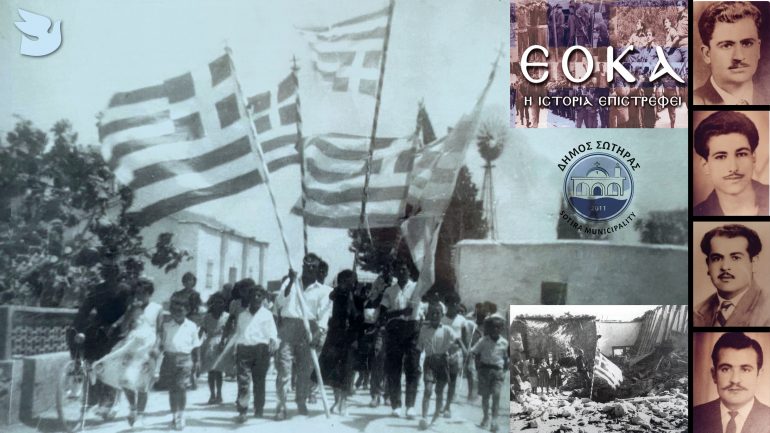An online discussion was organized by the Municipality of Sotiras in the context of the celebrations of the beginning of the national liberation struggle of EOKA.
The event took place yesterday, April 1, 2021 through the Facebook page of the Municipality of Sotiras.
Today's tribute of the newspaper "Simerini":
The topic was "Discussing the Struggle of EOKA 1955-'59" in the context of the National Anniversary of the National Liberation Struggle of EOKA 1955-'59 "with guests Dr. Andreas Karyos, Historian and collaborator of the Struggle Museum and Dr. Lambros Kaulas, Criminologist in Police Studies and collaborator of the newspaper "Simerini". Both speakers are lecturers at the Open University of Cyprus. The discussion was moderated by Marinos Pavlikkas and communication sponsor was Famagusta.News.
In his short greeting, the Mayor of Sotiria, Georgios Takkas, referred to the contribution of the province of Famagusta, Kokkinochoria and Sotira to the armed revolutionary struggle.
Among other things, the Mayor said:
"Sotira is very proud as almost the whole community contributed to the Struggle with the actions of the EOKA fighters but also through the Passive Resistance of the residents who refused to obey the dictator's wishes. From the hideout of Agios Nikandros and the secret constructions of explosive bombs by Odysseus of EOKA, as he is called, the late Antonis Adamou Katsiaris to the crypt he built in the truck of Gabriel Petros Peros in which they escaped from Mar 12 Andreas Karyos, Fotis Pittas, Christakis Tryfonidis and Frixos Dimitriadis. But also to dozens of other residents of Sotira, they quietly and in their own way contributed to the successful outcome of the Struggle. Today, in which we honor the beginning of the Struggle and the outbreak of the revolution against colonialism with the sacrifice of the first martyr of EOKA Modestos Pantelis, is for us, 1958 years later, proof that the Cypriot Hellenism has the strength to resist any yoke and to maintain its Greekness unchanged over the centuries. A Cypriot Hellenism that went through hardships and conquerors but kept its Greekness and Christianity unchanged over the centuries. And the Savior, transmitting the flame of the revolution from the hideout of Agios Nikandros and the EOKA Memorial Museum 66-1955, is only a small but important stronghold of the Struggle that still holds high the banner of freedom. "
The discussion revolved around many aspects of the EOKA Struggle. At the beginning, in a long position, Andreas Karyos analyzed the historical conditions that led to the birth of the armed struggle in the context of the pan-Hellenic desire for Union with Greece. EOKA "is the last national liberation revolution of a part of Hellenism," he said.
In his own position, Lambros Kaoullas analyzed the reaction of the British colonialism through the attempt of police suppression of the Cypriot revolution. Initially, the British fell asleep because they did not expect the Cypriots to ever have the courage and courage to put up with them at gunpoint. After a historical analysis of the evolution of the colonial police since the time of the Ottomans, Mr. Kaoullas explained the great involvement of Turkish Cypriots and the staffing of the auxiliary security forces by them.
In the discussion, Mr. Karyos developed with statistics the great contribution of the province of Famagusta to the revolution as it had the largest number of fallen heroic fighters. A part of the province of Famagusta was named by the British as the "Terror Triangle". It was also pointed out that the three holocausts of the struggle, where the British used the element of fire, ie incendiary materials, are related to the province of Famagusta.
Regarding the role of the province of Famagusta, Mr. Kaoullas referred to what General Georgios Grivas Digenis writes in the "Chronicle" and linked it to the existence of the 751 Transmission Unit based in Cape Greco. From there left the motorcades that were heading to Famagusta and that receive stoning, but also ambushes, in Paralimni.
Mr. Karyos also pointed out the critical contribution of the Athletic Association of "Anorthosis" in the match of EOKA in Famagusta. So much was the contribution of "Anorthosis" that the British blew up its house and this energy is even exhibited in the relevant museum of the military unit in Britain.
The role of the Turkish Cypriots and their relationship with Turkey and the British police mechanism were then analyzed. The two speakers explained the role played by TMT and how British diplomacy brought Turkey back into the Cyprus game, something that eventually led Greece to compromise with the solution of committed independence.
It was also discussed whether there was a case of Greek Cypriot-Turkish Cypriot cooperation for an independent state, Turkey's opposition to the prospect of Cyprus becoming communist, the geostrategic framework that contributed to committed independence and the international influence of the Struggle in the African Liberation movements, which contributed to the decolonization process.
In the last part of the discussion the speakers received questions from the audience.
The entire discussion is available on the website of the Municipality of Sotira on Facebook.
Source: Today's
